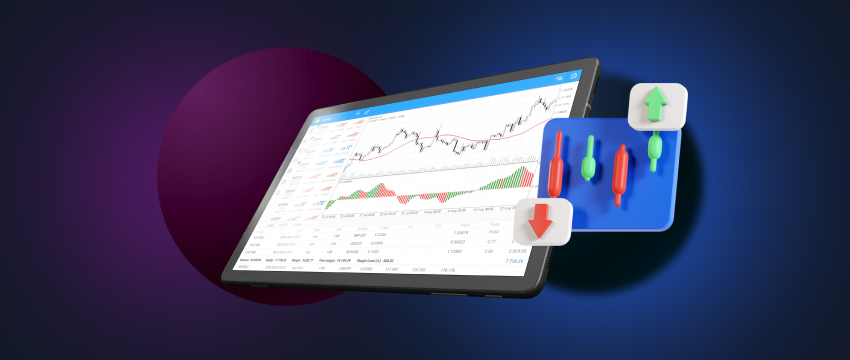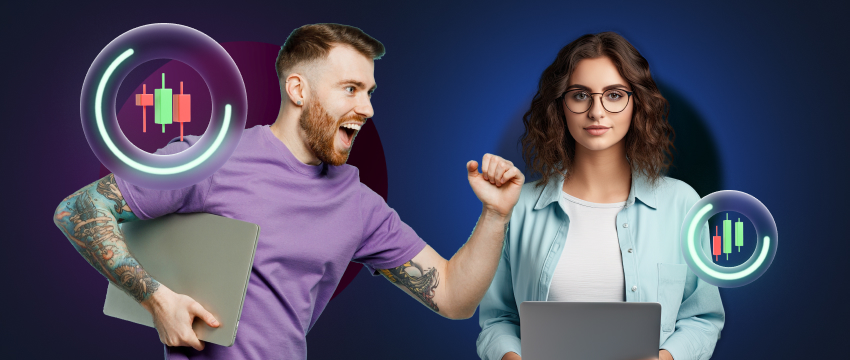Leverage and margin are two of the most popular trading terms and vital concepts that require robust understanding. While the two terms are closely interwoven, they do play different roles. In this article, we’ll explore the delicate relationship between leverage and margin, and knowing how to manage both is pivotal to safeguarding your capital.
What is leverage?
Leverage essentially refers to borrowed funds. It is a sum of money that a trader borrows from a broker to open and manage larger positions beyond what their account balance can accommodate. Traders use leverage to express the size of their position relative to the margin requirement. A trader utilizes leverage to enhance potential profit from forex trading. Some brokers may limit the amount of leverage a trader can access, particularly in the case of new traders.
An example of how leverage is calculated:
If the EUR/USD exchange rate increases by 100 pips, moving from 1.1305 to 1.1405, and you have invested $1000, your gains from that transaction would be $10. If however, you made use of leverage of 1:100, it means that each $1 you invest carries a value of $100. Therefore, with your $1000 margin, you can open a $100,000 position. As a result, your $10 profit is amplified to $1000.
What is an appropriate amount of leverage?
There is no clear-cut answer to this question as how much leverage a trader utilizes is generally based on:
- The trader’s level of expertise
- How new the trader is to trading
- The trader’s tolerance for risk (i.e., how much risk they’re willing to take on)
- The extent to which the leverage aligns with the trader’s goals and budget
- The trading strategy the trader chooses to adopt
Regardless of how new someone is to trading, however, even the most experienced trader needs to manage leverage carefully. This means making use of an effective risk management plan that integrates effective tools to mitigate losses. This includes the adoption of stop-loss and take-profit orders to protect your investments.
Additionally, a risk management plan will also help you better manage some of the emotions that arise during trading. Be this fear, greed, impulsion, etc – a risk management plan will set the rules, the framework if you will, dictating how to execute trades, leaving very little to chance or feelings. In turn, this will also increase confidence and focus, thereby increasing your potential for making strategic trading decisions and achieving more successful trading outcomes.

What is margin?
In the context of forex trading, margin refers to the sum of money a trader is required to deposit into their trading account to open and manage a position. The margin requirement is typically set by the broker but usually varies depending on the currency pair you want to trade and your position size. Margin is not a transaction fee. The use of the term margin differs depending on context. Used margin for instance refers to the amount of capital a broker blocks to keep a trader’s positions open.
Usable margin (or free margin as it is sometimes called) refers to the margin amount you have available in your account to execute new trades. Maintenance margin on the other hand is the minimum amount required to continue holding a position open.
But what happens when a trader’s account balance falls below a certain threshold? This does happen, largely because leverage is incredibly volatile and can quickly magnify losses when a trade moves in an adverse direction. In the event a trader’s balance does drop below a specific amount, a margin call may be triggered. This typically involves the broker requesting the trader to deposit more funds into their trading account to either cover the losses or simply close a position to avoid losses being magnified.
Using a trading plan to manage leverage and margin
In the same way, a risk management plan will help you better safeguard your capital, an overall trading plan will help you optimize your entire trading experience.
A trading plan is a vital tool to manage your trades, including the use of leverage and margin.
The trading plan is ideally comprised of the following key components:
- Trading goals. A trading plan should define your objectives so that you remain focused on the end goal.
- Trading strategies. The trading plan should also include the strategies you intend to use to achieve your objectives.
- Financial instruments. The plan must specify the types of financial instruments you intend on trading and the markets you’ll focus on.
- Position sizing. The trading plan should state the size of each position you want to open. For purposes of spreading risk, avoid putting too much capital on one particular trade.
- Risk management approach. Your plan must include the risk management techniques you intend to utilize and which align with your risk tolerance.
- Ongoing learning. Regardless of where you are at in your trading journey, your trading plan should set time aside for continuous learning. This entails the consumption of trading-related educational resources that will widen your scope of knowledge, boost your skills, and keep you up to date with any new trends or technological advancements.
The T4Trade Academy offers plenty of resources to help you acquire more knowledge and capabilities to use leverage or margin effectively. This includes material like blogs, e-books, videos, podcasts, seminars, Live TV, and even a real-time Economic Calendar to monitor global economic releases and events. Each resource offers a variety of trading tips, insights, concepts, and strategies, catered to all types of traders, from beginners to those with years of experience.
Remember, a trading plan can also be adjusted as you gain more experience or realize that a specific strategy isn’t working as well for you. However, remember to never put the money you don’t have at risk, especially funds that have been set aside for important milestones like retirement, university studies, purchasing a home, or even a car, etc.

Signing up for a demo trading account
Another way to learn how to better use leverage or manage margin is to gain trading practice by using a demo trading account. Select a reputable broker like T4Trade and access a demo account that provides a simulated trading platform to execute trades. Using virtual funds, open and close positions, and gage outcomes. Use leverage to identify the impact on the profitability of trades, and apply risk management measures to establish how to protect yourself from substantial losses.
Additionally, discover how to use technical and fundamental analysis without putting your funds at risk. Learn how to read charts, economic indicators, objects, etc, to make informed trading decisions. With time, you will gain much-needed experience and a whole lot more practical knowledge to be able to move to a live trading environment.

Why trade with T4Trade?
By becoming a T4Trade trader, you can enjoy trading 300+ financial instruments from across 6 asset classes. Diversify your portfolio with access to instruments like forex, commodities, metals, indices, futures, and 股票. You will also be able to choose from a variety of accounts that best cater to your years of experience and trading goals.
T4Trade also offers tight spreads, fast execution, quick withdrawals and deposits, flexible leverage, and a user-friendly trading platform. The broker’s multilingual client support team is also on hand 24/5 to answer the questions that traders worldwide are asking. They can be reached via email or Live Chat.
免责声明: This material is for general informational and educational purposes only and should not be considered investment advice or an investment recommendation. T4Trade is not responsible for any data provided by third parties referenced or hyperlinked in this communication.




